Jeff Edwards’ primary school teacher had just started the day’s math lesson when an ominous rumble sounded in the distance.
“The next thing I remember was waking up,” he later recalled. “My right foot was stuck in the radiator and there was water pouring out of it. My desk was pinned against my stomach and a girl’s head was on my left shoulder. She was dead.”
Over the next hour and a half, the then-8-year-old Edwards struggled to breathe as his classmates, trapped under a torrent of liquefied coal waste, cried out around him. With every passing minute, he said, “They got quieter and quieter, … buried and running out of air.”
Around 11 a.m., someone spotted a tuft of Edwards’ blonde hair amid the rubble. A fireman used a hatchet to free the young boy from beneath his desk, then passed him along to safety via a human chain. Edwards, the tenth child rescued that morning, would be the last survivor pulled from the debris.
In total, the October 21, 1966, disaster killed 144 people, 116 of whom were students at the Welsh town of Aberfan’s Pantglas Junior School. The tragedy, according to BBC News’ Ceri Jackson, was a “mistake that cost a village its children”; in the words of a tribunal commissioned to investigate the incident, the deadly accident “could and should have been prevented.”
The Aberfan disaster features heavily in season three of Netflix’s award-winning series “The Crown,” which returns to viewers’ screens this Sunday after a two-year absence. To ensure the television biopic portrayed the incident “truthfully and responsibly,” the cast and crew consulted survivors and current residents of Aberfan. Per a statement from the show’s producers, “All strongly felt the Aberfan disaster and the events that followed must be included, especially as it continues to hold a deep resonance for the nation and the queen herself.”
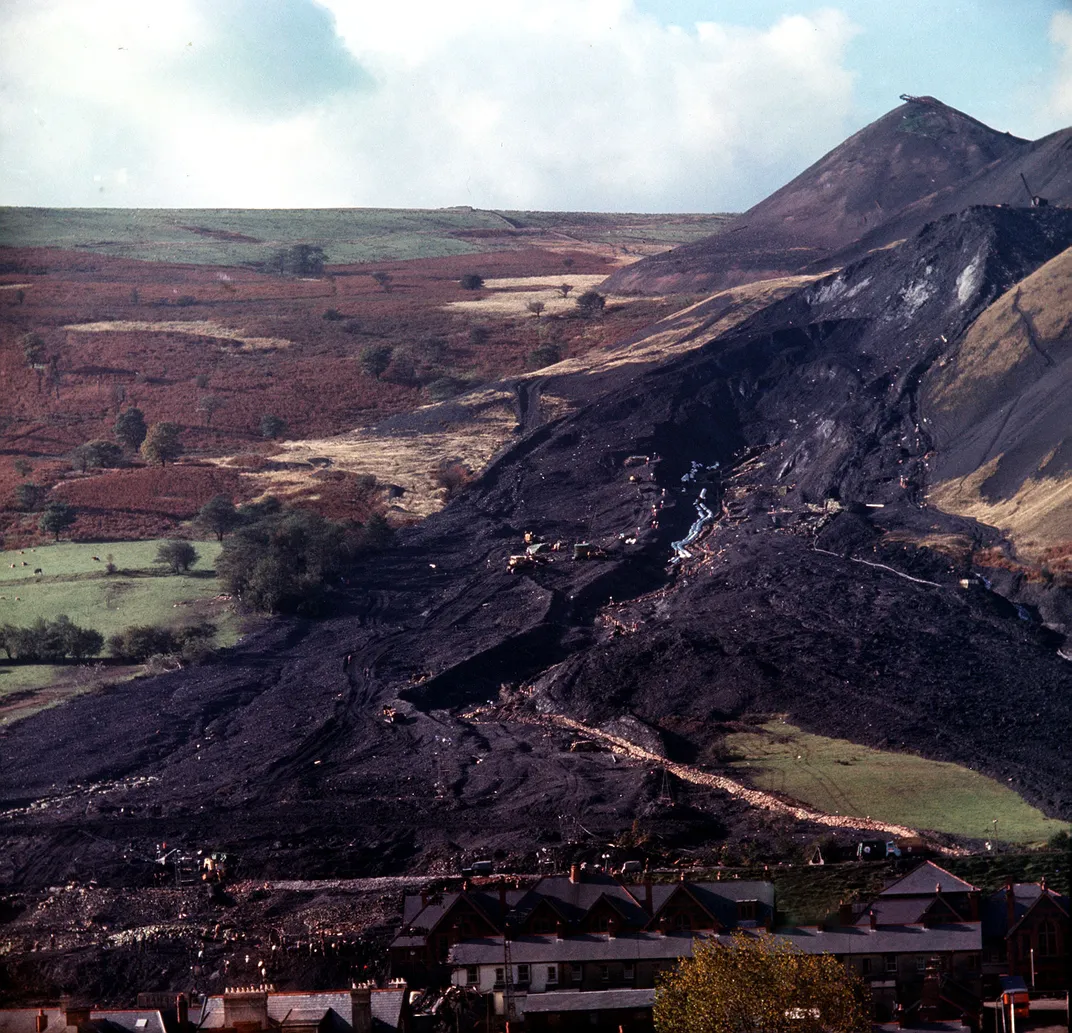
Much like the days that preceded it, the morning of the disaster found Aberfan, a southern Wales village home to some 8,000 coal miners and their loved ones, blanketed in a wet fog. The 240 students enrolled in the school walked to class in the rain, but few were focused on the weather. Instead, the children’s conversations centered on plans for the coming half-term holiday: Following an early afternoon assembly, all students would be dismissed for vacation.
Several years earlier, the local council had contacted the National Coal Board, which ran the nearby Merthyr Vale Colliery mine, to express concerns regarding the spoil tip—a massive pile of accumulated coal waste material removed during mining—situated just above the Pantglas school.
“I regard it as extremely serious as the slurry is so fluid and the gradient so steep that it could not possibly stay in position in the winter time or during periods of heavy rain,” one engineer wrote in a June 1963 letter.
The NCB not only ignored these complaints, but implicitly threatened the town’s livelihood. Per BBC News, the unionized mining giant made its intentions clear: “Make a fuss and the mine would close.”
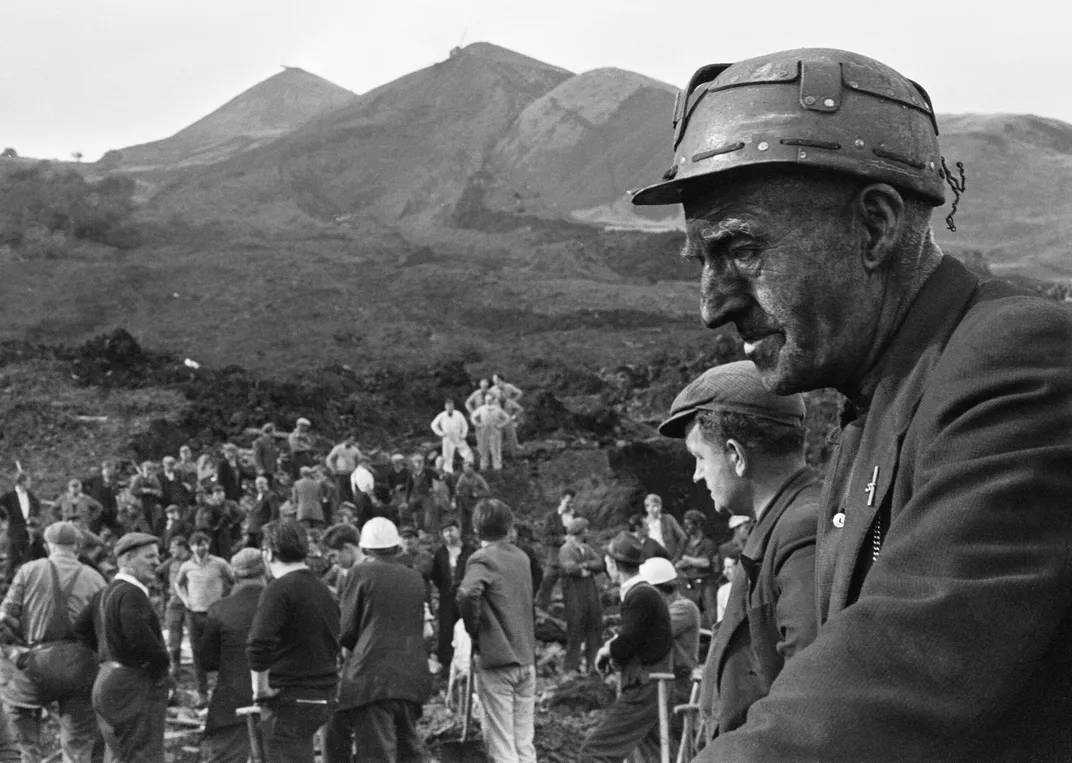
At the time of the disaster, the tip in question, number seven, rose 111 feet aboveground and contained nearly 300,000 cubic yards of waste. Set atop an underground spring covered by porous sandstone, the heap was precariously placed and, thanks to the recent rainy weather, extremely oversaturated.
At 7:30 a.m., workers assigned to the tip discovered that it had started to slide. Although the crew opted not to move forward with the day’s planned tip operation, they were unable to prevent further slippage, and at 9:15 a.m., a “glistening black avalanche” of liquefied coal waste, or slurry, began hurtling toward the village below.
“I thought I was seeing things,” crane driver Gwyn Brown later told investigators. “Then it rose up pretty fast, at a tremendous speed. ... It sort of came up out of the depression and turned itself into a wave—that is the only way I can describe it—down toward the mountain.”
According to History Extra’s Steve Humphries, the 30-foot-tall “tsunami of sludge” raced down the hill at a speed of more than 80 miles per hour. Sweeping past a canal and an embankment, the landslide tore into the Pantglas Junior School, breaching the walls of four classrooms and trapping those inside in a flood of thick, quicksand-like sludge.
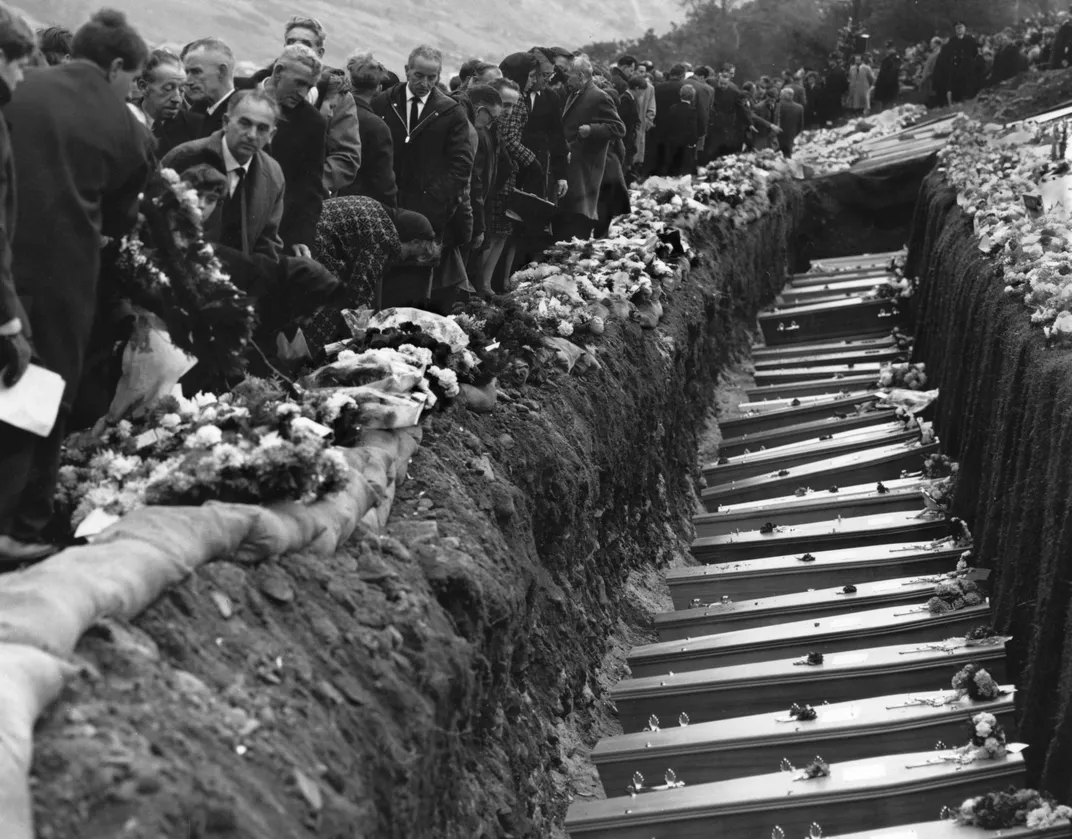
In the immediate aftermath of the onslaught, an eerie silence settled across the area.
“Everything was so quiet,” Cyril Vaughan, a teacher at the nearby senior school, said. “[It was] as if nature had realized that a tremendous mistake had been made and nature was speechless.”
Rubble and water from burst pipes exacerbated the already dire situation. As fireman Len Haggett recounted, rescuers who arrived on the scene found rising waters threatening to engulf 10-year-old Phil Thomas, who had been caught in the sludge as he was walking to school. “The water was rising and coming up to his head,” Haggett said. “We thought he might drown.” But a group of seven firefighters managed to lift the wall that had collapsed on Thomas, and he became one of the few to successfully escape the debris.
Five students survived the disaster thanks to the quick thinking of dinner lady Nansi Williams, who sacrificed herself by shielding them from the sludge with her own body. Another staff member, teacher David Beynon, died while cradling five of his pupils. None of the students in Beynon’s class survived.
Eight-year-old Jeff Edwards, rescued from the rubble around 11 a.m., was the last person found alive. But shocked parents, miners, police officers, firefighters and volunteers continued digging long after the last child’s cry could be heard. As Alix Palmer, a reporter who arrived to survey the mayhem the following day, wrote in a letter to her mother, “Men who had started digging at 9:30 the previous morning were still digging, with shirts off and bodies sweating despite the cold.”
Charles Nunn, a detective tasked with cataloging the bodies brought to the makeshift morgue in Aberfan’s Bethania Chapel, sorted through the deceased’s pockets in search of “a handkerchief, sweets, anything that might help with identification.” Parents walked along the rows of corpses laid on pews, lifting blankets covering the bodies until they spotted a familiar face. Those whose children hadn’t yet been found repeated the ritual daily, leaving the chapel to stand in line once again, “mother relieving father, to keep their place outside waiting in the rain.”
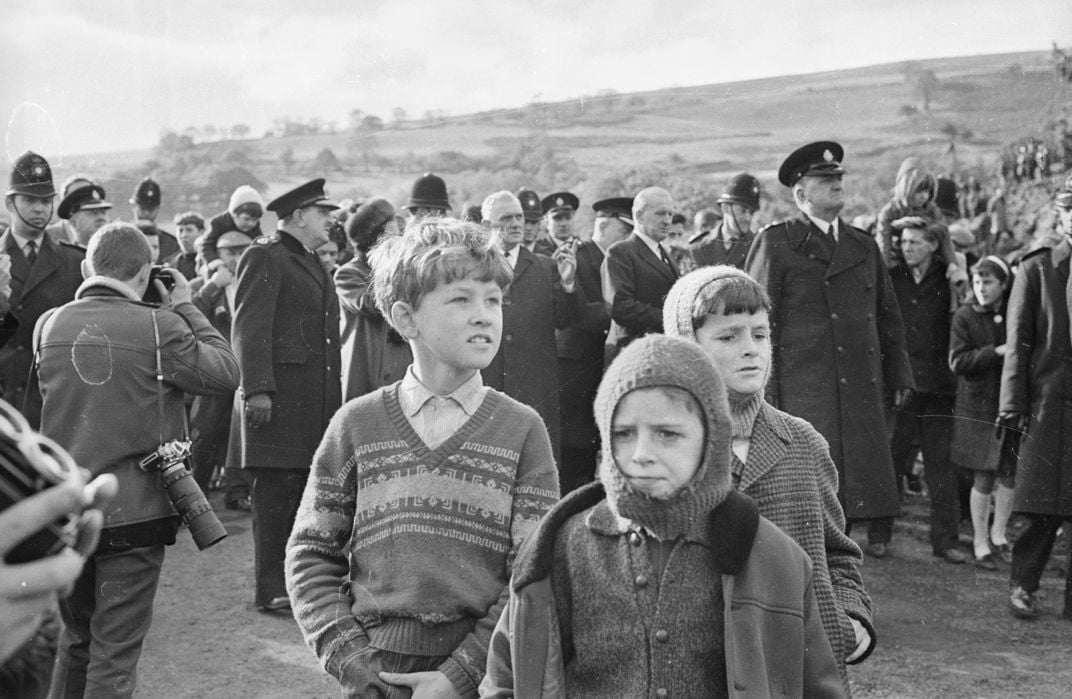
Fifteen days after the landslide, Nunn and his team finally left Aberfan. They had identified 144 bodies, including those of 116 children, 5 teachers and 23 locals whose homes were destroyed by the deluge. According to Johnson, the victims ranged in age from three months to 82; of the 116 students, most were aged 7 to 11.
Episode three of “The Crown”’s new season finds Elizabeth II, played by newly minted Oscar laureate Olivia Colman, debating how best to address the situation. England’s prime minister, Harold Wilson (Jason Watkins), urges her to visit the mining village and console its grieving residents in person, but the queen is reluctant to do so, suggesting her presence would distract from the tragedy at hand. Describing Wilson’s directive to “comfort people” as simply a “show,” she declares, “The Crown doesn’t do that.”
The real Elizabeth didn’t visit Aberfan until eight days after the disaster. Decades later, the queen reportedly deemed this decision her “biggest regret.”
Elizabeth’s time in the village—biographer Robert Lacey said her “gaunt features, etched with grief, were the more moving for being so clearly genuine”—signaled a shift in the monarchy’s long-held tradition of stoicism. As Jen Chaney writes for Vulture, the moment dramatized in “The Crown” offers “one of multiple hints that modern times are beginning to demand more transparency and outward empathy from the royal family.”
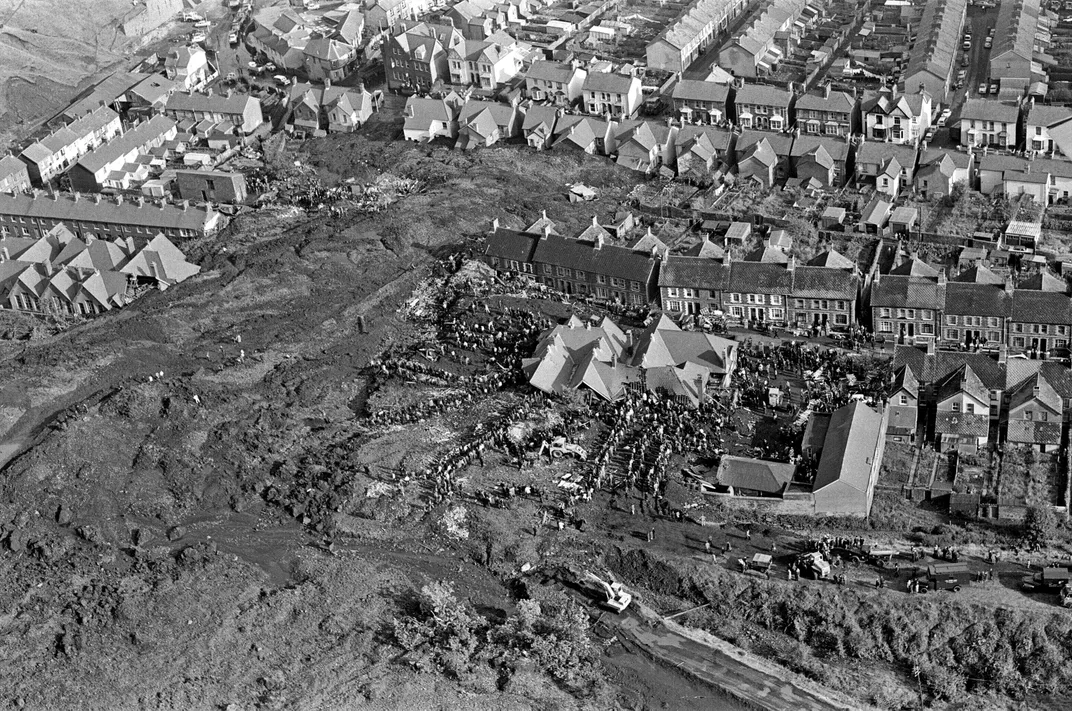
A tribunal tasked with investigating the Aberfan disaster published its findings on August 3, 1967. Over the course of 76 days, the panel had interviewed 136 witnesses and examined 300 exhibits. Based on this evidence, the tribunal concluded that the sole party responsible for the tragedy was the National Coal Board.
“The Aberfan disaster is a terrifying tale of bungling ineptitude by many men charged with tasks for which they were totally unfitted, of failure to heed clear warnings, and of total lack of direction from above,” the investigators wrote in their report. “Not villains but decent men, led astray by foolishness or by ignorance or by both in combination, are responsible for what happened at Aberfan.”
Per History Extra, the NCB’s chairman, Lord Robens, denied all wrongdoing. He attributed the accident to previously unknown springs located below the spoil tip and refuted testimony suggesting the tip had shown signs of slipping in the years prior to the disaster. Both of these claims were at odds with the physical evidence examined by the tribunal.
Photographs and footage of the deadly slurry avalanche generated sympathy across the globe, and in the months following the disaster, donors contributed a total of £1,750,000. (Today, this equates to around £20 million pounds, or more than $25 million USD.)
Much of this money failed to reach the villagers whose lives had been devastated by the tragedy. As BBC News reports, the commission in charge of distributing the funds allocated £150,000 toward removal of the town’s remaining tips after the NCB refused to cover the costs; meanwhile, the fund’s managers actually considered distributing compensation on the basis of how close parents had been to their deceased children. Thankfully, the commission soon moved away from this plan, instead offering bereaved parents £50 each. Later, this figure was raised to the “generous offer” of £500.
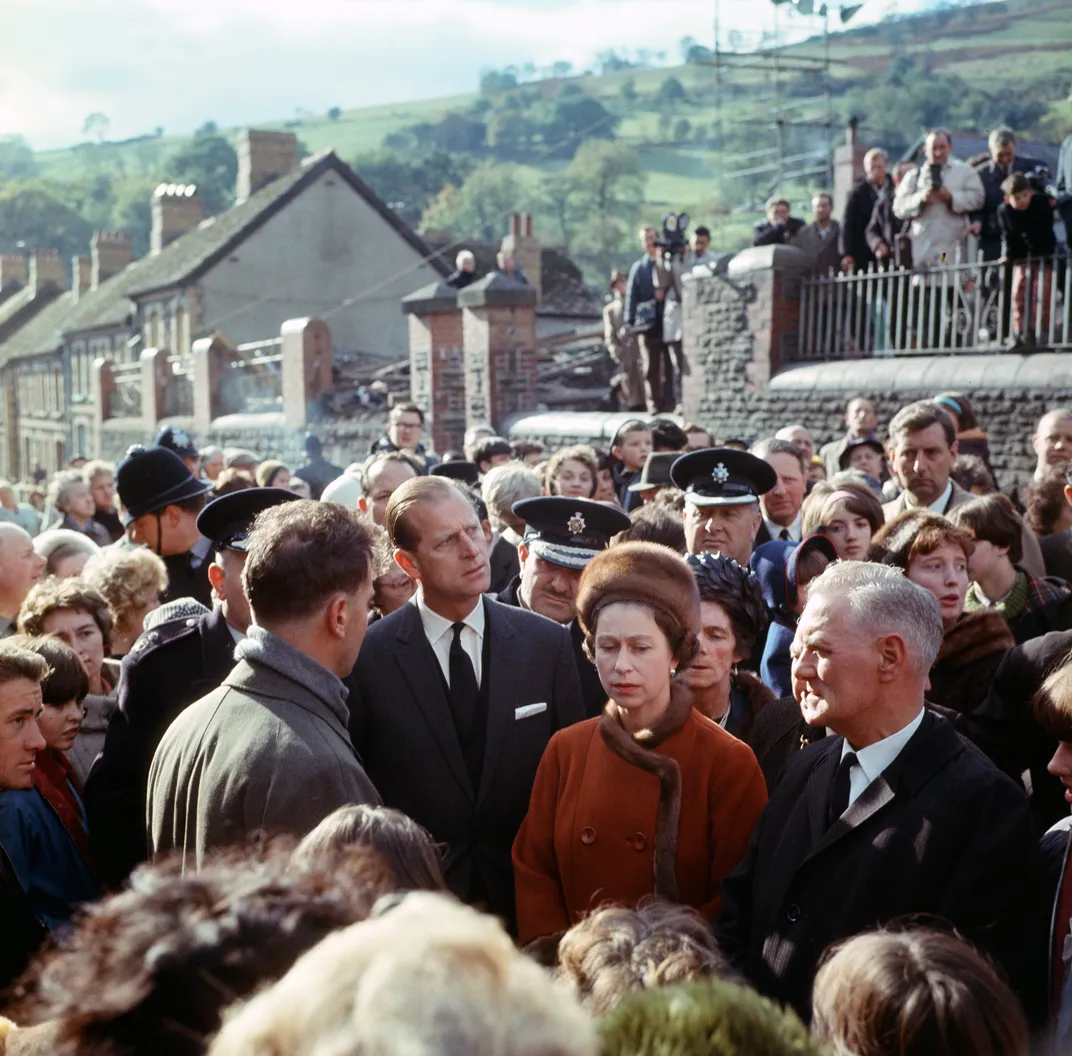
The psychological scars suffered by survivors endured long beyond the 1966 disaster. Edwards, the last child pulled from the razed school, told Wales Online that he relived the trauma in the “days, the weeks and the months after.”
“I was afraid of noise, I was afraid of crowds, I was afraid of going to school,” he added, “and for many years I couldn’t go to school because I was afraid that something would happen to me.”
Melvyn Walker, 8 years old at the time of the disaster, echoed Edwards’ sentiments, saying, “[The sound of children playing] gives me flashbacks. I get very anxious even to this day. If I hear children’s voices it takes me straight back.”
Speaking with ITV News’ Juliet Brenner on the 50th anniversary of the tragedy, Edwards concluded, “Most of my friends in my class died. … Basically we were happy-go-lucky children, looking forward to the half-term holidays, and at 9:15 our childhood stopped.”
Since the Aberfan disaster, the queen has returned to the tiny Welsh town three more times. Although Elizabeth was unable to attend a memorial ceremony held on the 50th anniversary of the tragedy, her son Prince Charles read a statement from his mother detailing the “heart-breaking inscription” written on a posy given to her by a young girl during the 1966 visit: “From the remaining children of Aberfan.”
“On this saddest of anniversaries,” the queen added, “I send my renewed good wishes to you all.”
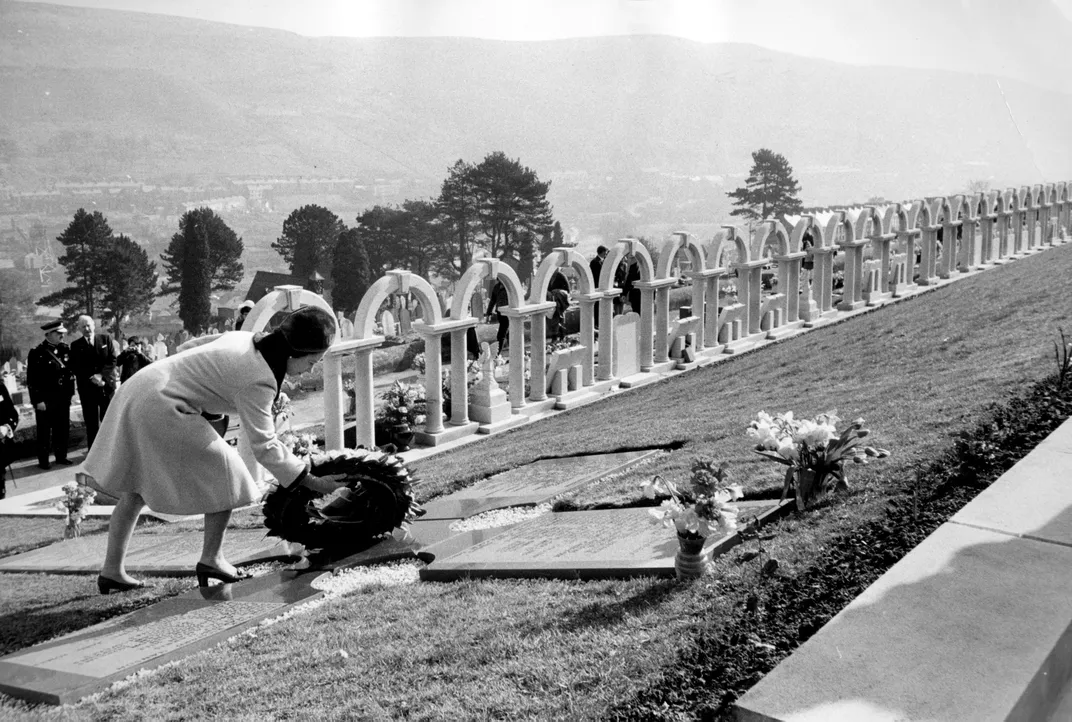
/https://tf-cmsv2-smithsonianmag-media.s3.amazonaws.com/filer/11/b6/11b606ab-d331-4d9a-b77f-f48c8c543a3d/gettyimages-853780528.jpg)
/https://tf-cmsv2-smithsonianmag-media.s3.amazonaws.com/filer/49/ab/49ab0f80-61a6-4f74-bb94-1a307a09903f/gettyimages-3399002.jpg)
/https://tf-cmsv2-smithsonianmag-media.s3.amazonaws.com/accounts/headshot/mellon.png)
/https://tf-cmsv2-smithsonianmag-media.s3.amazonaws.com/accounts/headshot/mellon.png)